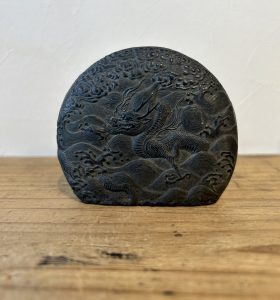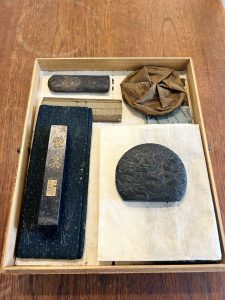美しい筆文字は永遠のあこがれです(愛知県名古屋市千種区姫池通 骨董品買取 古美術風光舎)
2024.05.01
みなさまこんにちは、スタッフHでございます。
先日スタッフYが写真を載せておりましたが、満開のつつじが目を引く季節ですね。先日濃いピンクと純白のつつじが並んで咲いていて、おめでたい!と思ってしまいました。実はつつじの鮮やかな赤紫色を指す名前に躑躅色(つつじ色)というのがあるそうです。平安時代からある伝統色だそうで、清少納言の「枕草子」にも「躑躅色は冬の下襲に良い色だ」と記されているのだとか。
大河ドラマなどを観ていると平安時代の色の多様さに驚かされるのですが、他にも目を奪われるものがあります。登場人物がさらさらと筆で書く仮名文字の美しさです。無性に書いてみたくなり、筆ペンを引っ張り出してきて書いてみるのですが、似ても似つかない仕上がりとなります。
それにしても書きたいと思った時に毎回墨をするのは大変な労力だったのではと想像します。
ところで墨をするの「する」は「磨る」とう漢字を使うそうです。硯の平らな面で優しく磨くイメージで磨ると綺麗な墨を作り出すことができるのだとか。とろっとした粘りが出て、墨の良い香りがふっと立つ瞬間が磨り終わりの目安とされています。
さて風光舎にも新しく中国の「古墨(こぼく)」が陳列されています。両面の龍の絵柄に風格を感じます。


墨は煤(すす)と膠(にかわ)と香料を混ぜ合わせて作られ、日本で作られたものを「和墨」、中国で作られたものを「唐墨」といいます。中国における墨の歴史は日本よりはるかに長く、紀元前1500年頃の殷の時代に始まったとされています。それから時代ごとに数多くの製墨家が現れ、特に文化大革命前の墨は寿命が長く、「古墨」と呼ばれ珍重されています。
長期保存により墨の質も変化し、膠は分解がすすみ「枯れた」状態になるといいます。膠が枯れた状態の墨は伸びがよく墨色に立体感が出て様々な表現が可能になるといわれています。
唐墨は一般的に日本の墨より膠の含有率が高いため墨のおり方が遅く黒味が出にくい一方で粘り気が弱く、柔らかく品のある墨色がでるそうで、漢字書道をされる方に人気があるのだそうです。
日本への墨の伝来は諸説ありますが、中国から文字が伝来したころだといわれています。奈良時代には仏教の中心地だった今の奈良市で写経や学問に使う墨づくりが盛んになり、現在まで継承されています。和墨には粘り気が強い膠が使われ、煤の割合が多いため墨のおり方が早く、強い黒が出せるといいます。
墨は作られる国の風土、水などの違いによりそれぞれ発展し、書道を嗜む方々は用途により使い分けているそうです。いずれにしても墨で書かれた文字は1000年残ると言われております。
高校の書道の授業で中国の書家として知られる王羲之の「蘭亭序」を書き写すという機会があり、当時一体何を書いているのかも分からず、苦労した記憶があります。少しトラウマでもあるようで「蘭亭序」という言葉すら忘れられない状態ですが、年を経て少しは書の趣も感じられるようになりました。
美しい筆文字がすらすらと書けたらどんなに楽しいだろうかと改めて妄想しております。
それでは、また次の機会に。

Hello everyone, this is Staff H.
As Staff Y posted a picture the other day, it is the season of azaleas in full bloom. The other day, azaleas in deep pink and pure white were blooming side by side! I thought to myself, “Congratulations! Actually, there is a name for the bright reddish purple color of azaleas: azalea azalea-iro. It has been a traditional color since the Heian period (794-1185), and in Sei Shonagon’s “The Pillow Book” it is written that “azalea color is a good color for winter raids”.
When I watch historical dramas, I am amazed at the variety of colors used in the Heian period, but there is something else that catches my eye as well. The beauty of the kana characters written by the characters with a brush is also a sight to behold. I was so inspired that I pulled out my brush pen and tried to write them, but the result was nothing like the original.
I imagine it must have taken a lot of effort to ink the brush every time he wanted to write.
By the way, the Chinese character for “ink” is “polish”. The inkstone’s flat surface is used to polish the ink gently to produce a beautiful ink. The moment when the ink becomes thick and sticky and the good aroma of the ink is released is considered to be the end of the polishing process.
The Fuhkosha also has a new display of Chinese “koboku” (old ink). The dragon design on both sides gives a sense of elegance.
Sumi ink is made by mixing soot, glue, and spices. The history of sumi ink in China is much longer than that of Japan, and is said to have begun around 1500 BC during the Shang Dynasty. In particular, ink produced before the Cultural Revolution has a long life span and is called “Ko-Boku” (old ink) and is highly prized.
The quality of ink changes with long-term preservation, and glue decomposes and becomes “withered”. It is said that the dead glue gives the ink a three-dimensional effect and allows for a variety of expressions.
In general, Tang ink has a higher content of glue than Japanese ink, which makes it slower to form ink and harder to produce black color, but it is less sticky and produces soft and elegant ink color.
There are various theories about the origin of sumi ink in Japan, but it is said to have been introduced to Japan around the time when Chinese characters were introduced to Japan. Japanese ink is made of glue, which is very sticky, and has a high percentage of soot, which is said to make the ink form quickly and produce a strong black color.
Sumi ink has been developed according to the differences in climate and water in each country where it is produced, and people who enjoy calligraphy use different types of sumi ink for different purposes. In any case, it is said that characters written in ink will remain for 1,000 years,
I remember that I had an opportunity to copy “Lanting Preface” by Wang Xizhi, a well-known Chinese calligrapher, in my high school calligraphy class, and I had a hard time understanding what he was writing. It seems I was a bit traumatized and I have not even forgotten the word “Preface to Lanting Pavilion,” but as the years have passed, I have come to appreciate the calligraphy a little more.
But I have come to appreciate calligraphy a little more now that I am older. I still fantasize about how fun it would be to write beautiful brush strokes with ease.
See you next time.
*******************
ご実家の整理やお片付けなどをされている方のご相談などが多くございます。
お片付けなどくれぐれもご無理のないようになさってくださいませ。
風光舎では古美術品や骨董品の他にも絵画や宝石、趣味のお品など様々なジャンルのものを買受しております。
お片付けをされていて、こういうものでもいいのかしらと迷われているものでも、どうぞお気軽にご相談下さいませ。
また風光舎は、出張買取も強化しております。ご近所はもちろん、愛知県内、岐阜県、三重県その他の県へも出張いたします。
まずは、お電話お待ちしております。
愛知県名古屋市千種区姫池通
骨董 買取【古美術 風光舎 名古屋店】
TEL052(734)8444
10:00-18:00 OPEN

